Tight and Sleek Gameplay; Versatile Approach to Exploration and Battles; Incredible Atmosphere; The Return of Samus
Very Hard Mode requires amiibo; New 3DS extra buttons not used
Samus never shows up until we need her the most.
Metroid: Samus Returns surprised us all when it was announced— a classic Nintendo franchise in limbo reappeared with a game in a style that laid long dormant. This, combined with the unveiling of Metroid Prime 4 for Nintendo Switch, gave Metroid fans a feeling they had not felt in nearly a decade: hope for the future of the series.
These hopes are resting on this Nintendo 3DS game, which embodies its “returns” moniker in many ways. It’s literally the return of the character of Samus. It’s a return to the mainline Metroid series. It’s a return to an often-overlooked Game Boy adventure that plays a critical part in the mythos. It’s the return of producer Yoshio Sakamoto, who carries with him a history. Most importantly, it’s a return to the classic gameplay style that Samus created— one that has flourished in her absence thanks to independent developers. It’s been a long time coming for the bounty hunter to take back the throne, and make us all remember exactly what we have missed.
The good news is that Metroid: Samus Returns is everything we have could have ever wanted, and then some. It’s a bold approach to Metroid that not only lives up to the legacy of this series but brings it to another level. MercurySteam (known for Castlevania Lords of Shadow) and Nintendo have created one of the greatest games to ever grace the Nintendo 3DS platform and one of the finest 2D action-adventure titles of this generation.
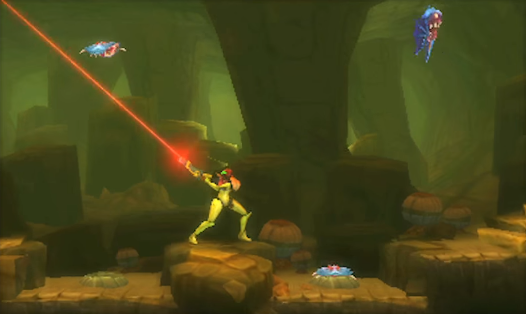
At the surface, Samus Returns is a remake of the 1991 Game Boy title Metroid II: The Return of Samus. However, like Zero Mission, it would be better served to call the game a reimagining rather than a remake. The basic premise of Metroid II is intact, and the foundations are present— but the additions go much farther than simply adding a coat of paint to a dated monochrome world.
Following her initial encounter with Mother Brain, Samus is called upon to descend onto the hostile terrain of planet SR388— the home world of the dangerous Metroids. Her mission: exterminate every last Metroid to ensure they do not fall into the wrong hands. The journey takes Samus deep into the subterranean depths of the planet, where secrets about the Metroids, their origins, and the ancient Chozo civilization lie in wait.
But you can expect the exposition to cut short after the opening cut scene. I am pleased to say that Metroid has returned to the “show, not tell” style of storytelling. Cryptic story elements are hidden within the environment, and unlockable images give tantalizing hints into the history of SR388. And yes, Samus never speaks a single word.
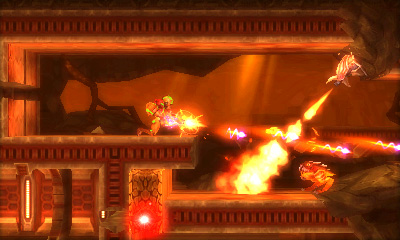
MercurySteam brings 2D Metroid to the future with amazing gameplay enhancements. Samus has never been nimbler, more accurate, or more versatile. The world has never been so easy and so fun to traverse. Goals and collectibles are kept hidden away, but never in a way that you will get stuck. Many quality of life improvements assist in alleviating any frustrations you can encounter.
It all feels very familiar but very fresh at the same time. This is the classic Metroid gameplay, and at its core the progression remains the same. Explore, find new tools, uncover secrets, revisit areas, and grow in strength. Completing the story will lead you through certain areas in a vaguely linear order, and you have to eliminate all the Metroids. But if you intend to coax out the deepest secrets of Samus Returns, you will need to comb the entire world several times. Many surprises lie in wait.
You might have seen the 360-degree aiming in the trailers, but once it’s in your hands, you will understand that shooting will never be the same. Samus can shoot anywhere within her line of sight, and that includes while hanging, jumping, and running. Weapons are handled much in the same way as the Game Boy Advance games, save for a new switchable beam that is swapped out by tapping the touch screen.
On that lower screen, the map and all information are available at all times. This leaves the top screen free of any HUD elements whatsoever, which is quite immersive. I’m going to miss that lower screen. One small disappointment: the extra buttons of the New 3DS are not given any functionality. Allowing you to enter morph ball with ZL and switch beams by tapping ZR would be a trivial addition.
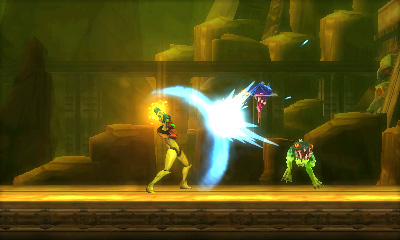
The melee counter deserves a special shout out, because it changes how you approach battles entirely. Do you go in guns blazing? Or do you patiently wait to counter enemy attacks and then go in for the kill? These choices keep things fresh and really make you feel like a badass when you get in a good counter without even stopping.
All of this added maneuverability means that enemies are fierce, and you have to keep up. The Metroids are very tough, and it will take some practice before you can get out of these battles unscathed. But have no fear, because you can tip the odds in your favor. New powerful Aeion abilities give Samus a limited supply of special powers to shield or deal serious damage in a tight spot. You can even use Amiibo to grant Samus optional reserve tanks that give you just a little more ammo or health if you screw up. And the days of making the walk of shame back from the save station are over. If you lose to a boss, you are returned to a checkpoint in front of the room. But do not expect any of this to save you if your battling skills are not up to snuff.
Samus’ repertoire will be very familiar to veterans of Metroid II, but a few additions like the aforementioned Aeion abilities make the cut. What’s remarkable is how so many old items are used for new purposes in Samus Returns. Brand new types of puzzles utilize weapons such as Morph Ball bombs and the Grapple Beam in intuitive ways. The spark to ingenuity is not always new power-ups, and the incredible level design really ties all of this together. Every piece of the puzzle fits and there are no shortage of “aha!” moments where you figure out how to create a shortcut or reveal a new path.
And for those players craving the ultimate challenge, the game offers higher difficulty modes. Unfortunately, the toughest difficulty mode can only be unlocked with a Metroid Amiibo. This was quite the controversial decision that caused some fan outrage, but that’s the way it is.
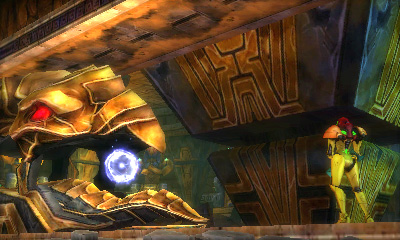
Metroid II was a technical feat on the original Game Boy, and the trend continues in Samus Returns. The title is pushing the aging original Nintendo 3DS to its limits, but never once does it stutter or skip. All of the characters and environments— down to the smallest rocks and baddies— are rendered in 3D polygons, giving a great sense of depth and life to the world. This allows the full potential of the stereoscopic 3D to shine, and it looks fantastic. Environmental effects pop out from the screen such as dust slightly obscuring the view, or waves of heat emanating from pools of lava.
A huge part of the atmosphere is the sound design in Samus Returns, which is absolutely phenomenal. An auditory landscape is painted in every level, with particular attention paid to the sounds effects and ambient noises. Samus’s armor lightly clanks while moving around, and the eerie cries of the Metroids can be heard in the distance. A good pair of headphones will do wonders.
Metroid II is known for its minimalist soundtrack, focusing on sparse, unsettling and otherworldly sounds to add to your isolation and dread. Returns captures the feeling of this atmosphere and even remixes this music but, obviously, the sounds are more robust and less repetitive. In the areas with traditional music, there are a few notable returning Metroid tunes. This is complimented by a lineup of excellent new music. Overall, the vibe is slightly reminiscent of Metroid Prime 2, with heavy focus on the dark atmosphere and tension.
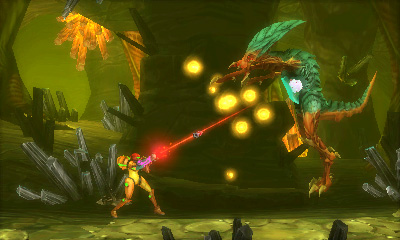
All of the other “Metroidvania” games from recent years all sought to fill a hole that Metroid left. While many of them are good, there’s nothing else like Metroid. The universe, the atmosphere, and the design are like no other. Metroid: Samus Returns is truly a triumphant resurgence for the series in all respects. It delivers nostalgia in all the right ways while reinvigorating what we thought a 2D Metroid could be. MercurySteam delivered in every way. Yoshio Sakamoto rediscovered the aspects that made the series great and dropped what didn’t work in Other M. This is one of the best Nintendo 3DS games ever made, and it’s releasing just in time to see the platform go into the twilight.
On a conceptual level, the game speaks to Nintendo’s constant refusal to retread ground unless there are new ideas to share and new stories to tell. Maybe Nintendo held a revisit to Metroid II so close to the chest for all these years for good reason. I would like to believe that Samus Returns took so long to materialize because it was carefully considered, and set up to be a milestone for the franchise. Another era of Metroid is beginning.
See you next mission.




 ShareThis
ShareThis





